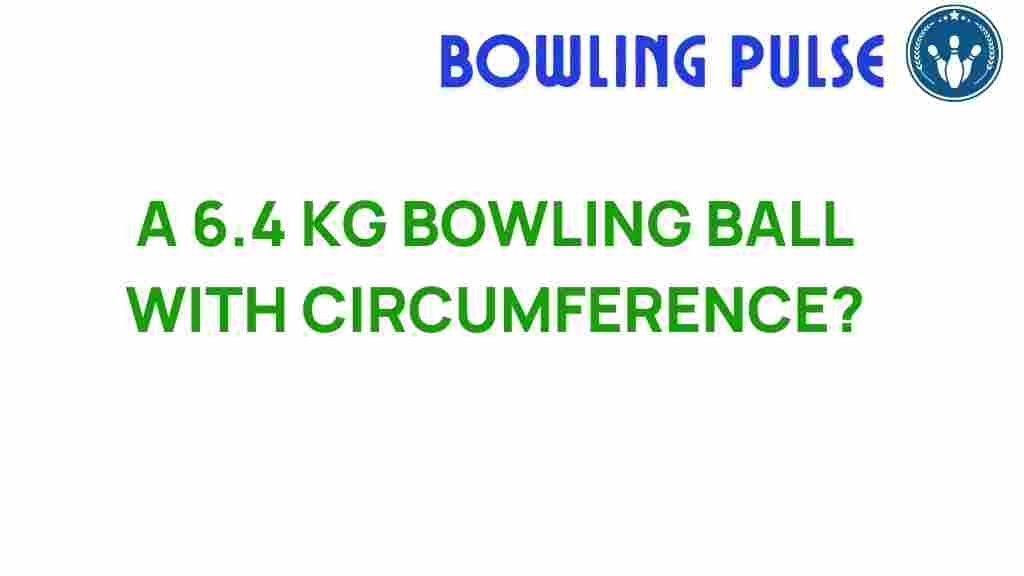Unraveling the Mystery of the 6.4 KG Bowling Ball’s Circumference
Bowling is not just a game of skill; it is a sport that intertwines physics, technique, and the right equipment. Among the most crucial pieces of sports equipment in bowling is the bowling ball itself. Understanding the relationship between a bowling ball’s weight, circumference, and overall design can significantly enhance your performance on the lanes. In this article, we will explore the fascinating world of bowling balls, focusing particularly on the 6.4 KG bowling ball, its circumference, and how these factors influence your bowling technique.
The Basics of Bowling Balls
Bowling balls come in various weights and sizes, each designed for specific styles of play. The standard weight for adult bowling balls typically ranges from 6 to 16 pounds (approximately 2.7 to 7.3 KG). A 6.4 KG bowling ball falls within this range, making it a popular choice for many bowlers, especially beginners and those who prefer a lighter ball for better control.
Understanding Bowling Ball Circumference
The circumference of a bowling ball is a crucial measurement that affects how it rolls down the lane. To understand this better, let’s delve into how to measure the circumference and why it matters.
Measurement of Bowling Ball Circumference
The circumference of a bowling ball can be calculated using the formula:
C = π × d
Where:
- C = Circumference
- π = Pi (approximately 3.14)
- d = Diameter of the bowling ball
For a standard bowling ball, the diameter is usually about 21.6 centimeters (approximately 8.5 inches). Using this measurement:
C = 3.14 × 21.6 cm ≈ 67.9 cm
Thus, the circumference of a standard bowling ball is approximately 67.9 centimeters. For a 6.4 KG bowling ball, this measurement remains consistent, as the circumference does not change with weight alone.
The Physics Behind Bowling Ball Performance
Understanding the physics of a bowling ball can help bowlers make informed choices about their equipment. Several factors contribute to the performance of a bowling ball:
- Weight: The weight of the bowling ball affects its momentum and energy transfer when it strikes the pins. Heavier balls can knock down more pins, but they require more strength to control.
- Circumference: A larger circumference often means a larger surface area, which can influence grip and spin. It also affects how the ball interacts with the lane conditions.
- Material: Bowling balls are made from various materials, including polyester, urethane, and reactive resin. Each material offers different levels of friction and hook potential.
Choosing the Right Bowling Ball
Selecting the right bowling ball involves considering several factors:
- Bowling Skill Level: Beginners might prefer a lighter ball (like the 6.4 KG option) for better control, while experienced bowlers may opt for heavier balls for greater impact.
- Bowling Technique: A bowler’s technique can also dictate the ideal bowling ball weight and circumference. Bowlers who utilize a hook may benefit from a ball that offers more spin capability.
- Hand Size: Ensure the ball fits your hand comfortably. The finger holes should allow for easy gripping and release.
Bowling Techniques and Performance
To maximize the performance of your bowling ball, consider the following techniques:
- Grip: Proper grip is essential. A loose grip can cause a lack of control, while a tight grip can restrict movement.
- Stance and Approach: Your stance and approach play a significant role in how effectively you can deliver the ball. A balanced stance allows for better control and power.
- Release: The timing of your release can impact the ball’s trajectory and spin. Practice releasing the ball smoothly to achieve the desired effect.
Tips for Improving Your Bowling Technique
Here are some tips to enhance your bowling technique:
- Practice regularly to develop muscle memory.
- Watch videos of professional bowlers to learn techniques and styles.
- Consider taking lessons from a certified bowling coach.
- Experiment with different weights and designs to find what feels best for you.
Common Issues and Troubleshooting Tips
Even the most seasoned bowlers encounter issues. Here are some common problems and how to troubleshoot them:
- Ball Hooking Too Much: If your ball hooks excessively, consider adjusting your grip or the position of your fingers in the holes. A less aggressive ball may also help.
- Lack of Power: If your shots lack power, focus on your approach and follow-through. Ensure you are using your legs to generate momentum.
- Inconsistent Release: Work on your timing. Practice the release to make it smoother and more consistent.
Design Innovations in Bowling Balls
The bowling ball industry has seen numerous design innovations that enhance performance. Key advancements include:
- Core Design: The core of the ball affects its weight distribution and overall dynamics. Asymmetrical cores can create a stronger hook.
- Coverstock Technology: New materials and textures on the ball’s surface help improve grip and performance on different lane conditions.
- Custom Fit: Many manufacturers now offer custom drilling options to ensure the ball fits the bowler’s hand perfectly, enhancing control and comfort.
Conclusion
Understanding the intricacies of a 6.4 KG bowling ball’s circumference, weight, and design is crucial for any bowler aiming to improve their game. By grasping the physics behind bowling balls and employing effective techniques, players can enhance their performance and enjoy a more rewarding bowling experience. Remember, the right sports equipment paired with a solid understanding of how to use it can make all the difference on the lanes.
For more information on bowling techniques and equipment, visit Bowling Tips and Tricks. You may also explore Bowling Science for a deeper dive into the physics of bowling.
This article is in the category Equipment and created by BowlingPulse Team

4 thoughts on “Unraveling the Mystery of the 6.4 KG Bowling Ball’s Circumference”